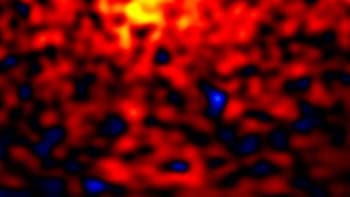
The best estimate yet of how much mass is contained within the long, tenuous threads of hot gas thought to span the vast distances between galaxy clusters has been made by a team of astrophysicists in Europe. The researchers used the XMM-Newton X-ray satellite to characterize three “filaments” of plasma extending from the galaxy cluster Abell 2744. Such filaments are believed to make up a cosmic web that permeates the universe, and the team says that the filaments are likely to contain much of the universe’s ordinary or “baryonic” matter.
Observations of the afterglow of the Big Bang known as the cosmic microwave background (CMB) suggest that protons, neutrons and other (three-quark) baryon particles only account for about 5% of the universe’s energy density – the rest is believed to consist of enigmatic dark matter and dark energy. However, the combined mass of all of the stars within a radius of about a billion light-years from Earth only amounts to about 2.5% of the energy density within that region. Computer simulations predict that the missing baryons instead exist within low-density plasma filaments millions of light-years long.
Indeed, in regions of the sky containing two galaxy clusters, smaller groups of galaxies can be seen tracing out a line between the clusters. These filaments are thought to permeate the universe, creating a “cosmic web” of galaxy clusters that is surrounded by an extremely low-density “void”. The seeds for this web can be seen in the tiny fluctuations within the CMB; as the universe expanded, gravitational attraction caused slightly denser regions to accumulate mass, while less-dense regions lost mass.
Good target
To measure the baryonic mass of several filaments, Dominique Eckert of the University of Geneva in Switzerland and colleagues looked towards Abell 2744, which is a vast galaxy cluster with a mass 1000 trillion times that of the Sun lying about four billion light-years from Earth. Like other clusters, its mass consists of galaxies (about 2%), gas (around 15%) and dark matter (80–85%). It is a good target, say the researchers, because its composition suggests that it is located at the intersection of several filaments of the cosmic web.
Although the gas in the filaments would be cooler than that in the cluster – at around several million degrees, as opposed to some 100 million degrees – it would still be hot enough to radiate at X-ray wavelengths. Eckert and his colleagues turned XMM-Newton towards Abell 2744 for 30 h last December, and studied the X-ray emission from the cluster and from a large volume of space around it.
The researchers identified three structures of interest, each of which is several tens of millions of light-years long. A close match between the position of these structures and the location of galaxy concentrations away from the centre of the cluster allowed Eckert and colleagues to conclude that they had observed filaments of the cosmic web.
Hot gas
“Where we see hot gas, we see galaxies,” says Eckert. “This is telling us that these galaxies are embedded in this cosmic web, and that we are seeing the gas within the filaments.”
The team worked out the temperature and density of the plasma in each of the filaments using the X-ray spectra and a model that simulates emission from very dilute plasmas. This revealed that each cubic metre of filament typically contains no more than a few tens of particles. While this may seem paltry, it is some 200 times greater than the average density of baryons in the universe.
Trillions of solar masses
The researchers then established what fraction of the filaments’ total mass the gas represents. To do so, they studied images from the Hubble Space Telescope and ground-based telescopes of galaxies lying behind Abell 2744, and worked out how much the light from those galaxies is bent by the gravitational pull of the intervening matter. They concluded that the filaments each weigh in at a few tens of trillions of solar masses. In other words, the researchers say, gas makes up roughly 10% of each filament by mass, with most of the rest being dark matter.
According to Eckert, galaxy surveys and numerical simulations show that most of the universe’s galaxies and dark matter lie in the filaments of the cosmic web. As such, he says, if the filaments contain significant amounts of hot gas, then that gas would contain a sizeable proportion of all baryons – about half, he estimates. “Our findings strengthen evidence for a picture of the universe in which a large fraction of the missing baryons resides in the filaments of the cosmic web,” he and his colleagues wrote in a paper published in Nature.



